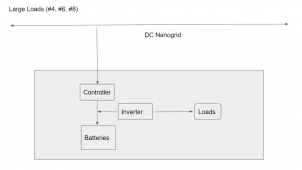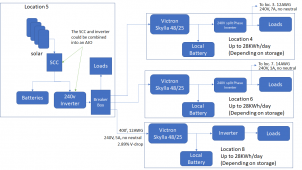Zardoz2525
New Member
- Joined
- Dec 1, 2021
- Messages
- 14
240V would be nice, but I could probably do without if necessary.

For the high draw site interconnects, I am hoping we can find equipment that allows us to just use a single phase 240V (no Neutral) on the pico grid.Please clarify the supply line here. When you say 240V are you talking about standard household service with +120V/-120V/neutral 3-wire connection or something else? What are we using as acceptable voltage drop?


Hmmm..... running the DC at very high voltage works, but then you would need a very high voltage inverter or a DC-DC voltage converter. I have never looked for or used inverters or converters that run at those voltages. I am sure they exist for industrial applications but they are going to be hard to find for this size application.That makes better sense. I thought we were at 240 3-wire and the wire size looked unreasonable. I make this at 2.6% loss in 10 gauge @ 600 ft. For the purpose of discussion I can get 2-conductor+ground UF-B for $0.53/ft at my usual place.
For the sake of discussion, I originally came in hoping something like this would work:
View attachment 117579
View attachment 117583
Basically hoping to reduce hardware count by wiring batteries in series to something in the 240 - 560V range, running the DC grid directly connected to the batteries, then converting at the point of use to 120 AC, rendering voltage drop moot.
Don't know enough to know why that is not practical, though I assume it is not, and I assume there is no reasonable way to backfeed from sites, but the savings in wire and hardware might pay for a few extra batteries at the main site.
yes.... kinda....but not really. The inverters can all be US (even the 240V ones). The Skylla has a universal input so it is international. The trick is that the Skylla does not need neutral...... so we don't run it across the pico grid.@FilterGuy - Do I understand correctly that I am basically using European equipment to run my grid at European standards then using the Skylla/Inverter pair as a bridge to American standards? I had not thought of that. Clever and inexpensive. My hat's off to you.
@FilterGuy - Do I understand correctly that I am basically using European equipment to run my grid at European standards then using the Skylla/Inverter pair as a bridge to American standards? I had not thought of that. Clever and inexpensive. My hat's off to you.
yes.... kinda....but not really. The inverters can all be US (even the 240V ones). The Skylla has a universal input so it is international. The trick is that the Skylla does not need neutral...... so we don't run it across the pico grid.



